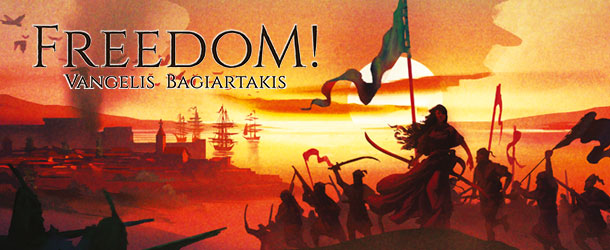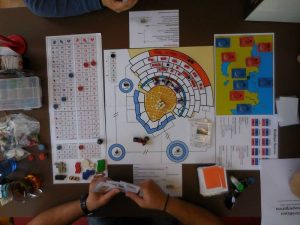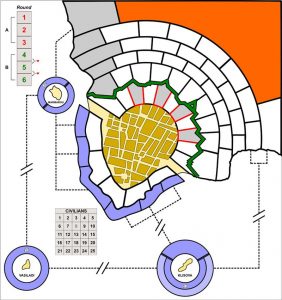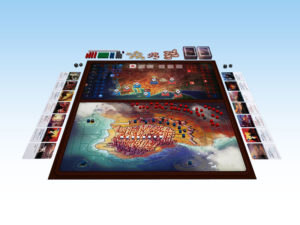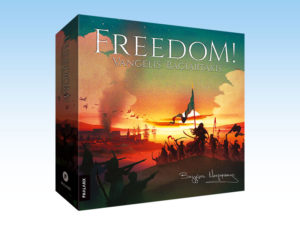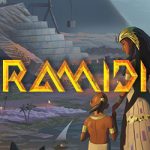The story behind the siege game Freedom!, by the game designer Vangelis Bagiartakis, arrives in its final part. The previous articles presented the conception of the game and its development - how the game would play. To conclude, he tells about the playtesting phase and how to get it published.
Early Playtests
The early playtests were very promising. The most important part was that the game gave the feeling we wanted it to give: In the beginning, the Ottoman Empire seemed invincible and like they would easily take the city. But as the game progressed, it would become apparent that it was not such an easy task, and they would have to work hard to achieve it. During the final rounds, on the other hand, the Greek player should feel like he is hanging from a thread, trying to survive just a tiny bit longer, while the Ottoman player should feel the pressure increasing - if they didn't take the city soon, everything would be lost.
The fact that we were on the right track didn't mean that there weren't changes needed to be made. One of the very first ones was to reduce the number of rounds. Twelve was too long and the game dragged a lot, so they were reduced to six - one for every 2 months. The fixed events were also removed. They made the game feel scripted and it gave an advantage to experienced players who knew what was coming, compared to new players who, on top of all the new rules they had just learned, also had to remember that. It was decided that putting the fixed Events in the deck with the rest of the cards was better. The problem however was that, historically, the siege was very different in the beginning compared to the end. Some events made little to no sense (thematically) if they appeared near the end of the game and vice versa.
The solution was relatively simple: the game was divided into two parts: Period A and B, with three rounds each. Consequently, the deck with the action cards was also divided into two parts. During the first three rounds the players would draw cards from the first deck and during the latter rounds, they would draw from the second one. This change was not only important for the gameplay, it also made perfect sense thematically: it was around six months in that the Sultan sent Ibrahim to help with the Siege, bringing with him his Egyptian troops who were better trained. Dividing the game in those two periods was a perfect fit since it allowed us to simulate that pivotal moment!
As the playtests progressed, more changes were made, this time to streamline some things. For example, it became apparent that filling and emptying the moat was something that the players never did. The Ottoman player would always go toward the part of the Wall that had an empty moat in the beginning and would attack from there. Then, the two players would go on filling and emptying the moat every turn, making for very uninteresting gameplay. I ended up removing the moat and no-one missed it a bit.
A couple more actions were affected similarly. According to the historic documents, the Ottomans would bring dirt and construct artificial hills in order to hide behind them as they advanced. By taking dirt from the back of these hills and pouring it in front of them, they would "move" those hills closer and closer towards the Wall. I had tried to incorporate that option in the game, but it was a bit complicated (especially for new players) and in the end it wasn't used as much. Even when it was, it didn't make a huge difference, so I ended up removing it completely and just left an Event in that referenced it.
Another change that was made was to the surrounding map. Having too many areas ended up not being helpful. The players would only focus on a few specific ones and would leave the rest as they were. Reducing the areas from 10 to 8 helped a bit, and I also made sure that more of these areas were referenced in the action cards.
Finally, I changed the mechanism of the request for Help from the Government. While it was nice, it added a lot of components to the game (since I needed to have many “YES” and “NO” cards) and it was time consuming to add/remove cards all the time and reshuffle constantly. The same effect could be had with a die and a track in which a modifier would advance each round. Initially, I used a twelve-sided die for this purpose, but it was soon turned to 2 regular dice. The game already had them - why add an extra component that wasn't used anywhere else? Not to mention that the 2d6 distribution made it more likely that you got the help in the second period of the game which was more appropriate/thematic.
All these changes helped the game a lot. It was now easier to play, things made more sense, and the number of components was realistic. More playtests helped us adjust a few more things and there was now only one thing remaining:
To find a publisher!
Finding a Publisher
Even though we had a great game in our hands that people enjoyed a lot and were very excited about, getting it published was not that easy.
The problem it was facing was a strange one: in Greece, the game's theme was extremely popular - a guaranteed seller! However, its mechanics were very complicated for the Greek main market. It was way more difficult to play compared to the mass market games found in toy stores, which made all the publishers very hesitant to proceed with its publication. On the other hand, in the English-speaking part of the world there were many people who would love to play such a game, but the theme was mostly unknown to them.
I wasn't ready to give up on the game though. I knew it was good, I knew its story was very interesting, and people would be fascinated by it. They just had to give it a chance first! So, with this in mind, I decided to try and find a publisher for the game during Spiel Essen in 2016.
At the time, PHALANX had released “The Magnates: A Game of Power” and “1944: Race to the Rhine” which were both stunning to look at. They had very good production values, very positive reviews, and the people behind them looked like they knew what they were doing. I decided to send an email and schedule a meeting during the fair.
I met with Jaro Andruszkiewicz at their booth and I started telling him the story behind the game. Right from the start I saw he was very interested in what I was describing, so I kept telling him more and more about the actual siege, its people, the idea behind the game, how everything tied thematically and so on. My passion and enthusiasm at that point went through the roof and he could tell. It was clear that I had found the right man for my game! In fact, as I said to Alexandros when we later spoke: "In a scale of 1 to 10, that meeting was an 11!"
After the fair, he got to try the game and he liked it a lot. The rest as they say, is history!
Conclusion
The game's journey was a long one and it will soon reach its destination. I couldn't have done this without Alexandros - it was thanks to him that the project started and his contribution regarding the historic facts was invaluable. I also want to specially thank Jaro for taking a chance and believing in this game. It means a lot to me!
Finally, I want to thank all of you who will give this game a chance. You may not know the history behind it but believe me, it is a fascinating one and you will enjoy it immensely! Especially when you consider how it affected the future of all Europe! Things today would have been very, very, different if it wasn't for this siege!

